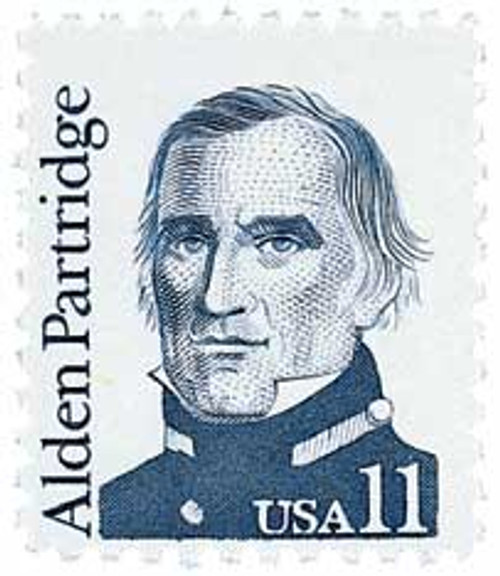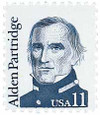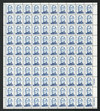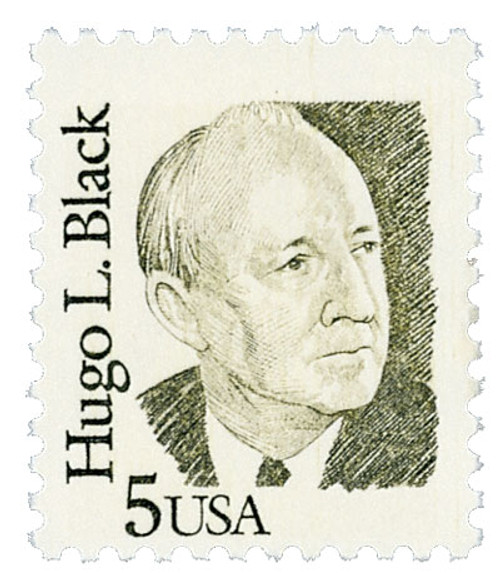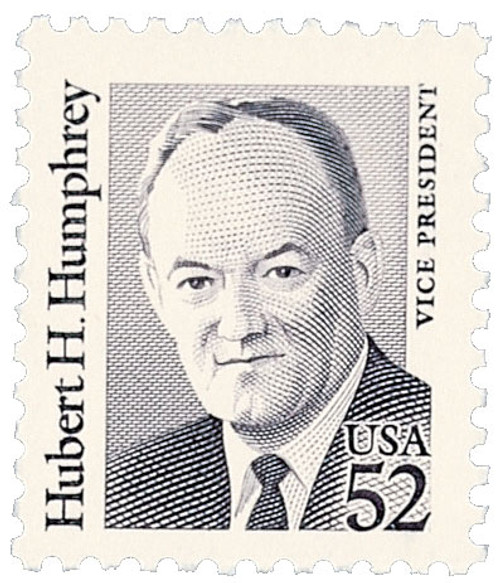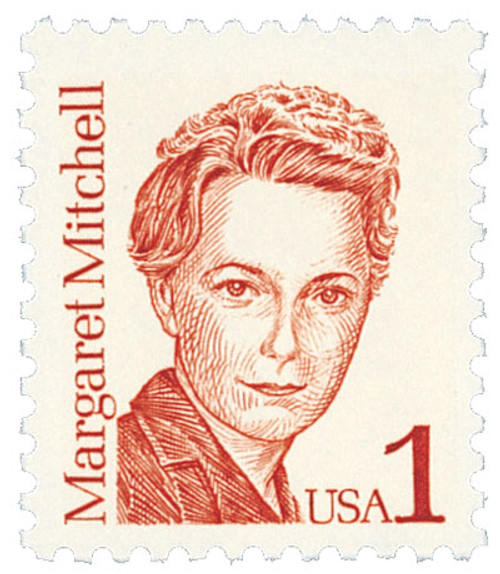
# 1854 - 1985 11c Great Americans: Alden Partridge
U.S. #1854
1985 11¢ Alden Partridge
Great Americans
- 19th stamp in the Great Americans Series
- Issued on Partridge’s 200th birthday at the university he founded
Stamp Category: Definitive
Series: Great Americans
Value: 11¢; for “make-up” postage
First Day of Issue: February 12, 1985
First Day City: Northfield, Vermont
Quantity Issued: 103,200,000
Printed by: Bureau of Engraving & Printing
Printing Method: Engraved
Format: Panes of 100
Perforations: 11
Color: Dark blue
Why the stamp was issued: This stamp’s value was requested by the Stamp Vendors Association, who requested an 11¢ “make-up” stamp. Partridge was seen as a controversial choice for a “Great Americans” stamp – he was once court-martialed for nearly launching a mutiny when he was replaced as head of West Point. However, he went on to found Norwich University, the first nonmilitary school in the western hemisphere, as well as seven other schools.
About the stamp design: Robert Anderson created the portrait on this stamp, based on an old engraving of Partridge in his fuss-and-feathers “Peacock” uniform.
First Day City: The First Day ceremony for this stamp was held at the Plumley Armory at Norwich University, which Partridge founded.
About the Great Americans Series: The Great Americans Series was created to replace the Americana Series. The new series would be characterized by a standard definitive size, simple design, and monochromatic colors.
This simple design included a portrait, “USA,” the denomination, the person’s name, and in some cases, their occupation or reason for recognition. The first stamp in the new series was issued on December 27, 1980. It honored Sequoyah and fulfilled the new international postcard rate that would go into effect in January 1981.
The Great Americans Series would honor a wider range of people than the previous Prominent Americans and Liberty Series. While those series mainly honored presidents and politicians, the Great Americans Series featured people from many fields and ethnicities. They were individuals who were leaders in education, the military, literature, the arts, and human and civil rights. Plus, while the previous series only honored a few women, the Great Americans featured 15 women. This was also the first definitive series to honor Native Americans, with five stamps.
The Bureau of Engraving and Printing (BEP) produced most of the stamps, but private firms printed some. Several stamps saw multiple printings. The result was many different varieties, with tagging being the key to understanding them. Though there were also differences in perforations, gum, paper, and ink color.
The final stamp in the series was issued on July 17, 1999, honoring Justin S. Morrill. Spanning 20 years, the Great Americans was the longest-running US definitive series. It was also the largest series of face-different stamps, with a total of 63.
Click here for all the individual stamps and click here for the complete series.
History the stamp represents: Alden Partridge was born on February 12, 1785, in Norwich, Vermont.
The son of a Revolutionary War veteran that fought at Saratoga, Partridge was a studious and outdoorsy child. He enjoyed hiking the Green and White Mountains and worked on his father’s farm in addition to attending school.
Partridge attended Dartmouth College as well as the US Military Academy at West Point. After graduation, he was made a lieutenant of engineers and appointed assistant professor of mathematics at West Point. In 1808, Partridge was promoted to professor of mathematics and also became acting superintendent.
Partridge was an active West Point superintendent and stressed the importance of physical fitness. He often personally led the cadets on long marches in New York and other nearby states. Partridge also made church service mandatory for his cadets and occasionally prepared and delivered his own sermons. In 1813 he was named professor of engineers and officially appointed superintendent the following year. Nicknamed “Old Pewt,” he became known as a micromanager who would play favorites with cadets, and a strict disciplinarian.
West Point’s “Long Gray Line” also began under Partridge’s leadership. In 1814 there was a shortage of blue cloth, so he approved the creation of gray uniforms. Two years later when the War Department was tasked with choosing a new cadet uniform, they chose gray because, “it better suits the finance of the cadets than one of blue.”
In 1817 President James Monroe appointed Partridge’s former student (but superior officer) Sylvanus Thayer to replace him as superintendent. Partridge initially refused but after a court martial agreed to resign in 1818.
That same year, Partridge was tasked with training a New York City volunteer infantry company and delivering a series of lectures on military science and education. Through these lectures Partridge called for a new type of local military education system, as opposed to the national academy system. He believed that the national academies produced military elite, rather than citizen soldiers like the great generals of the past such as George Washington and Andrew Jackson. Under Partridge’s plan, each state would have its own military departments with local soldiers in militias and units similar to the minutemen of the Revolution. His plan also called for military officer programs in each department.
Partridge had to take a break from his planning when he was tasked with surveying and establishing the border between the US and Canada as outlined in the Treaty of Ghent. He mapped the watersheds of the Saint Lawrence and Hudson Rivers before resigning so he could return to planning his own military college program.
In 1819 Partridge established his school – the American Literary, Scientific, and Military Academy, known today as Norwich University. During its first four years, the school had 480 students from 21 of the 24 states at the time. The school briefly moved to Middletown Connecticut for three years, but eventually returned to Norwich and later Northfield, Vermont.
In the coming years, Partridge founded six more military colleges in Virginia, Pennsylvania, Delaware, and New Hampshire. He also worked with faculty members as well as militia officer and future president Franklin Pierce to increase recruits and improve training and readiness of state militias.
In addition to his military career, Partridge worked as Vermont’s surveyor general and served four terms in that state’s House of Representatives. Partridge died on January 17, 1854 in Norwich. His legacy largely lies in the founding of Norwich University, which remains America’s oldest private military college. It’s also known as the birthplace of the ROTC, because it was the first school to offer the Reserve Officers Training Program.
U.S. #1854
1985 11¢ Alden Partridge
Great Americans
- 19th stamp in the Great Americans Series
- Issued on Partridge’s 200th birthday at the university he founded
Stamp Category: Definitive
Series: Great Americans
Value: 11¢; for “make-up” postage
First Day of Issue: February 12, 1985
First Day City: Northfield, Vermont
Quantity Issued: 103,200,000
Printed by: Bureau of Engraving & Printing
Printing Method: Engraved
Format: Panes of 100
Perforations: 11
Color: Dark blue
Why the stamp was issued: This stamp’s value was requested by the Stamp Vendors Association, who requested an 11¢ “make-up” stamp. Partridge was seen as a controversial choice for a “Great Americans” stamp – he was once court-martialed for nearly launching a mutiny when he was replaced as head of West Point. However, he went on to found Norwich University, the first nonmilitary school in the western hemisphere, as well as seven other schools.
About the stamp design: Robert Anderson created the portrait on this stamp, based on an old engraving of Partridge in his fuss-and-feathers “Peacock” uniform.
First Day City: The First Day ceremony for this stamp was held at the Plumley Armory at Norwich University, which Partridge founded.
About the Great Americans Series: The Great Americans Series was created to replace the Americana Series. The new series would be characterized by a standard definitive size, simple design, and monochromatic colors.
This simple design included a portrait, “USA,” the denomination, the person’s name, and in some cases, their occupation or reason for recognition. The first stamp in the new series was issued on December 27, 1980. It honored Sequoyah and fulfilled the new international postcard rate that would go into effect in January 1981.
The Great Americans Series would honor a wider range of people than the previous Prominent Americans and Liberty Series. While those series mainly honored presidents and politicians, the Great Americans Series featured people from many fields and ethnicities. They were individuals who were leaders in education, the military, literature, the arts, and human and civil rights. Plus, while the previous series only honored a few women, the Great Americans featured 15 women. This was also the first definitive series to honor Native Americans, with five stamps.
The Bureau of Engraving and Printing (BEP) produced most of the stamps, but private firms printed some. Several stamps saw multiple printings. The result was many different varieties, with tagging being the key to understanding them. Though there were also differences in perforations, gum, paper, and ink color.
The final stamp in the series was issued on July 17, 1999, honoring Justin S. Morrill. Spanning 20 years, the Great Americans was the longest-running US definitive series. It was also the largest series of face-different stamps, with a total of 63.
Click here for all the individual stamps and click here for the complete series.
History the stamp represents: Alden Partridge was born on February 12, 1785, in Norwich, Vermont.
The son of a Revolutionary War veteran that fought at Saratoga, Partridge was a studious and outdoorsy child. He enjoyed hiking the Green and White Mountains and worked on his father’s farm in addition to attending school.
Partridge attended Dartmouth College as well as the US Military Academy at West Point. After graduation, he was made a lieutenant of engineers and appointed assistant professor of mathematics at West Point. In 1808, Partridge was promoted to professor of mathematics and also became acting superintendent.
Partridge was an active West Point superintendent and stressed the importance of physical fitness. He often personally led the cadets on long marches in New York and other nearby states. Partridge also made church service mandatory for his cadets and occasionally prepared and delivered his own sermons. In 1813 he was named professor of engineers and officially appointed superintendent the following year. Nicknamed “Old Pewt,” he became known as a micromanager who would play favorites with cadets, and a strict disciplinarian.
West Point’s “Long Gray Line” also began under Partridge’s leadership. In 1814 there was a shortage of blue cloth, so he approved the creation of gray uniforms. Two years later when the War Department was tasked with choosing a new cadet uniform, they chose gray because, “it better suits the finance of the cadets than one of blue.”
In 1817 President James Monroe appointed Partridge’s former student (but superior officer) Sylvanus Thayer to replace him as superintendent. Partridge initially refused but after a court martial agreed to resign in 1818.
That same year, Partridge was tasked with training a New York City volunteer infantry company and delivering a series of lectures on military science and education. Through these lectures Partridge called for a new type of local military education system, as opposed to the national academy system. He believed that the national academies produced military elite, rather than citizen soldiers like the great generals of the past such as George Washington and Andrew Jackson. Under Partridge’s plan, each state would have its own military departments with local soldiers in militias and units similar to the minutemen of the Revolution. His plan also called for military officer programs in each department.
Partridge had to take a break from his planning when he was tasked with surveying and establishing the border between the US and Canada as outlined in the Treaty of Ghent. He mapped the watersheds of the Saint Lawrence and Hudson Rivers before resigning so he could return to planning his own military college program.
In 1819 Partridge established his school – the American Literary, Scientific, and Military Academy, known today as Norwich University. During its first four years, the school had 480 students from 21 of the 24 states at the time. The school briefly moved to Middletown Connecticut for three years, but eventually returned to Norwich and later Northfield, Vermont.
In the coming years, Partridge founded six more military colleges in Virginia, Pennsylvania, Delaware, and New Hampshire. He also worked with faculty members as well as militia officer and future president Franklin Pierce to increase recruits and improve training and readiness of state militias.
In addition to his military career, Partridge worked as Vermont’s surveyor general and served four terms in that state’s House of Representatives. Partridge died on January 17, 1854 in Norwich. His legacy largely lies in the founding of Norwich University, which remains America’s oldest private military college. It’s also known as the birthplace of the ROTC, because it was the first school to offer the Reserve Officers Training Program.

